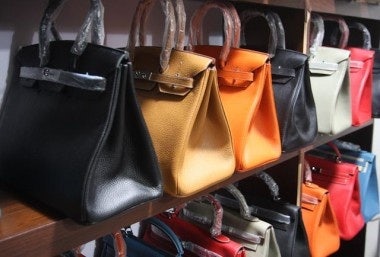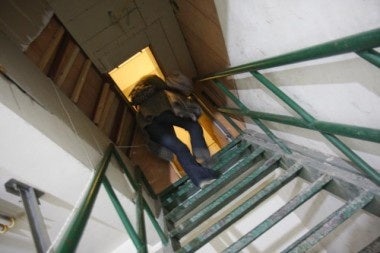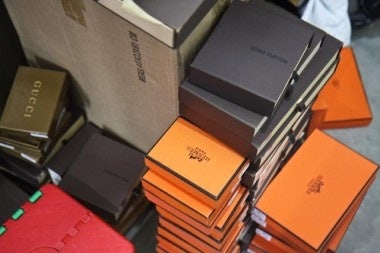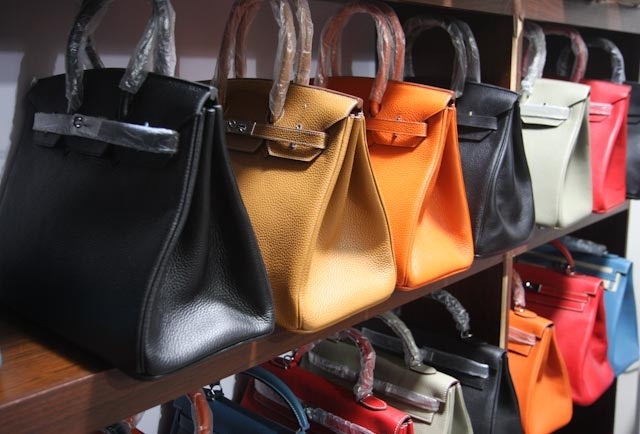"Hello, Lady. Do You Like Some Louis Vuitton?"#

A fashion industry veteran with more than six years in Paris under her belt, writer/photographer and Shanghai newcomer Sara White Wilson fills us in on her induction into the Shanghai luxury scene. In her first dispatch, Sara takes us into the less glamorous side of the city's booming high-end market and introduces us to the luxury good that dare not speak its name: the counterfeit.
Prior to my arrival one week ago in Shanghai, China, I was a counterfeit virgin. I have never owned one, I have never shopped for one, nor have I ever really seen one up close. I work amongst luxury brands every day, I have a host of acquaintances working in intellectual property law under the eager auspices of Bernard Arnault and I spend a lot of time in the 7th arrondissement of Paris, where Arnault and members of the Hermès family reside. I fear at any turn I would be spotted and silently shamed (at best) or arrested (at worst) if dare I sport a falsey. You could say, in the religion of authentic luxury, I am deeply god-fearing.
China is the world production center for counterfeit goods (it is estimated that 85 percent of the world's imitations are made here). Foreign businesses are lobbying with the government to halt this black beast of a market, to deter significant dents in figures related to employment and gross national product. These are just some of the complex concerns at hand, alongside child labor and copyright infringement.
My foray into the depths of the fakes was a thrill (and a cheap one at that). With seasoned expatriates as my guide, I enter an indoor market area, less than a 10-minute walk from the luxury mecca Plaza 66; I am accosted with this very nice address of Lady. We approach the more accessible stalls, such as "Wendy Shop" and, amidst the Longchamp, Marc Jacobs, and Goyard bags, my partners in crime enter into heated negotiation concerning a certain Burberry. The lowest they can negotiate is still about 100 euros.
Then we got to see the good stuff. It was agreed, between they and the vendor, that we would rendez-vous in the secret spot. We exit the shopping area, enter an adjoining building, and take an elevator to the 30th-something floor to arrive at a cosmetic surgery office, offering procedures that render the eyes more doe-like and open. We sneak behind the full-length advertising signs into a back storage room. We descend an iron staircase into a bare-bones basement. Alas, we are amidst the Hermès (delivered in signature orange boxes), the Birkins, and the Pradas - all in top form.
Here is what I have learned about the market for fakes:
- There are no taboos, in private.#
I descended into this secret marketplace with a professional camera. There was not one protest that I take photographs, nor one girl selling the goods who protested her face in a photograph. There was no fear in these merchants that what they were doing had any negative consequences.
- There are no taboos, in public.#
On the ground floor of "Shanghai's No. 1 Department Store" along the high street, I find a questionable cosmetics brand called "Chcédo" - meaning, Shiseido? In the window display advertising Crown luggage, the principle visual merchandising image incorporates the logo of the L.A. brand Chrome Hearts, doubtlessly nicked from the Internet. Shameless copyright infringement. But, Chrome Hearts, what are you gonna do about it?
- Not all fakes are created equal.#
There are the good fakes and there are the bad fakes. When I descended into the secret buying haven, I was amongst the best. Could we call them "luxury fakes"? Some of these products are actually decent leather bags that would be quite viable without a logo splashed upon it.
- The alternative is not so enticing.#
"It's what we do while we're here," say the long-term expatriates from Europe, and a Chinese friend who is well educated and widely traveled, insisting she's owned the real thing, too. Considering there is a 30 percent increase upon the price of luxury goods in mainland China due to importation taxes, buying a luxury product here, if one has other options, is just silly.

- The difference is in the details.#
I was almost sold on an Alexander Wang bag. Then I looked at the seams, and the split zipper. Ah, the seams. Time will tell. It always does. In ten years, how will this bag bear itself? In the details, furthermore, lies a degree of accountability. I once returned a Burberry wallet, that I purchased at their London flagship store, after a few years of use because I wasn't happy with how the leather was aging. They returned my money in full. I resisted the Alexander Wang effigy.
- Read the Card of Authenticity.#
Having worked as a commercial writer, I understand the importance of my job. "Burberry leather, the real genius of the Rudy family and with the success in developing urban life space and designing architecture wishes to share his merits by creating and introducing his leather goods collections which reflect his artistic life with the unique image of cosmopolitan style architecture design, perfect material coordination and art masterpiece."
+++
So is it a crime akin to identity theft, or is it free marketing for brands? Could we call it guerilla commerce; exploiting to competitive advantage the high margins of luxury goods as well as that mysteriously intangible asset, brand value?

I imagine what it must be like for those on the opposite spectrum, having never encountered the authentic products and aware of brands only through their imitations. The famous "Allegory of the Cave" comes to mind from Plato's Republic; a classic reference in philosophy. Cave dwellers see nothing but shadows and hear nothing but echoes, cast against a wall in front of them. The source of these shadows and echoes lies outside of the cave. The cave dwellers consider the shadows and the echoes to be the real and the only source because they are unaware of any alternative.
We can draw a parallel with brand perception, and the implications of authenticity and imitation.
Behold! human beings living in an underground den, which has a mouth open towards the light and reaching all along the den; here they have been from their childhood, and have their legs and necks chained so that they cannot move, and can only see before them, being prevented by the chains from turning round their heads. Above and behind them a fire is blazing at a distance, and between the fire and the prisoners there is a raised way; and you will see, if you look, a low wall built along the way, like the screen which marionette players have in front of them, over which they show the puppets.
And, earlier in the passage:
Is a resident of the cave (a prisoner, as it were) likely to want to make the ascent to the outer world? Why or why not?
That is the question brands should ask. Are buyers necessarily interested in the direct light of authenticity? Why or why not?
Writer and photographer Sara White Wilson has been dipped, doped and drinked in the luxury industry in Paris, France, for over six years. She has never previously been to China, she does not speak a word of Chinese and she is determined to rectify her ignorance.
A sampling of Sara's writing and photography can be found on her website, http://www.sarawhitewilson.com/.
